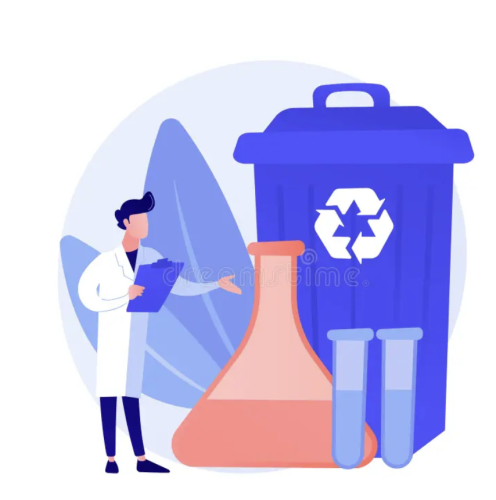Laboratory Waste Guide 2024

Laboratory Waste Guide 2024
From Chemicals to Sharps: Breaking Down the Categories of Laboratory Waste
Laboratory waste encompasses various materials such as chemicals, biological substances, contaminated glassware, disposable items, and others.
It can be classified into
- chemical waste
- biological waste
- radioactive waste
- and general non-hazardous waste.
Each category necessitates distinct handling and disposal techniques to avoid environmental contamination and ensure public safety.
How Proper Waste Management Mitigates Risks in Laboratories
Compliance with waste management regulations is essential for laboratories to maintain a safe working environment and prevent potential risks associated with improper disposal. Chemicals and biological waste materials used in laboratories can be harmful, flammable, or reactive, making effective waste management crucial. Inadequate waste management practices can lead to pollution of soil, water, or air, as well as contribute to the spread of diseases. Therefore, it is important for laboratories to prioritise proper waste management to ensure the safety of both the environment and personnel. Hence, it is crucial to adhere strictly to these disposal procedures due to the recent legislation that has imposed stricter environmental controls and increased disposal costs.
Certain solvents & chemicals that can be poured down the drain with running water include
- dilute or concentrated acids and alkalis,
- harmless soluble inorganic salts such as drying agents like calcium chloride, magnesium sulfate, sodium sulfate, and phosphorus pentoxide,
- alcohols containing salts (e.g., from destroying sodium),
- hypochlorite solutions used to eliminate cyanides, phosphines, etc., and fine-grade silica and alumina (TLC grade).
Important Note: Drains should never be exposed to any materials on the 'Red List'. The 'Red List' includes compounds containing antimony, arsenic, barium, beryllium, boron, cadmium, chromium, cobalt, copper, lead, mercury, molybdenum, nickel, selenium, silver, tellurium, thallium, tin, titanium, uranium, vanadium, and zinc; organohalogen, organophosphorus, or organonitrogen pesticides, triazine herbicides, and other biocides; cyanides; mineral oils and hydrocarbons; poisonous organosilicon compounds, metal phosphides, and phosphorus element; fluorides and nitrites.
Collection of solvent waste through incineration includes all types of organic solvents, including those that are water-miscible. It also involves the disposal of soluble organic waste, including the majority of organic solids. Additionally, paraffin and mineral oil from oil baths and pumps are included in this process.
All items suitable for standard council rubbish collection, excluding recyclable paper and glass, are considered as 'controlled waste.' This category includes dirty paper, plastic, rubber, and wood. These items are typically disposed of in lab bins and collected by cleaners. However, each lab should also have a separate container specifically designated for items that are not allowed in regular bins. This special controlled waste container should contain all broken lab glassware, sharp objects made of metal or glass, fine powders (preferably in a sealed bottle or jar), and dirty sample tubes or other items lightly contaminated with chemicals (excluding syringes and needles).
To prevent overflow, it is important to regularly empty lab-controlled waste containers. Avoid putting glass, sharp metal, or fine powder in regular lab bins. Before disposal, remove bottle tops and make sure there are no detectable chemical odours.
It is recommended to reduce the amount of special waste generated as this method is costly and inconvenient. Only dispose of the following items in this manner: Schedule 1 poisons (excluding cyanides) and other highly toxic chemicals, materials heavily contaminated with substances mentioned in point (i) above, materials contaminated with mercury, and carcinogenic solids such as asbestos.
For disposal, collect special waste in a separate bottle or jar that is labelled. It is important to never mix different types of special waste.
Immediate disposal is essential. It is important to dispose of special waste promptly after filling the container or completing the work. The accumulation of hazardous waste in laboratories is strictly prohibited.
To promote environmental sustainability, it is important to encourage the recycling of glass. However, it is crucial to note that only certain types of laboratory glass waste are acceptable for recycling. Therefore, each laboratory should have a dedicated bin specifically for recyclable glass. This bin should only be used for clean glass bottles, such as those used for storing chemicals, as well as broken or waste plate glass. It is important to dispose of all broken lab glassware, heavily contaminated items, sample tubes, droppers, and glass wool as controlled waste. It is worth mentioning that the recycling service will not accept bins that contain any prohibited items.
To refill bulk solvents, it is important to return winchesters that are specially labeled directly to the Store. These containers should not be contaminated and usually do not need to be washed. However, bottles that previously contained sodium should never be returned to the Store. When sodium is added to a solvent bottle for the first time, a designated label (which can be obtained from the Store) should be attached. After emptying the bottle, safely dispose of the sodium using ethanol or methylated spirit and remove the label. Finally, wash, dry, and return the bottle to the Store for refilling.
Empty Winchester bottles can be repurposed, such as for the disposal of waste solvents. Nevertheless, if these bottles previously held corrosive or harmful chemicals such as concentrated acid or ammonia, it is important to rinse them thoroughly with water before reuse.
Syringes and needles contaminated with biological hazards should be collected in specific containers for incineration. This applies to all types of syringes and needles, as requested by local councils. Do not dispose of syringes or needles in regular lab bins or controlled waste containers. However, it is important to note that this incineration method should not be used for Pasteur pipettes or other sharp objects unless they are contaminated with biohazardous materials.
In the United Kingdom, laboratory waste management is regulated by various laws and guidelines. The main legislation includes the Control of Substances Hazardous to Health (COSHH) Regulations, Environmental Protection Act, Hazardous Waste Regulations, and Radioactive Substances Act. Furthermore, organizations like the Health and Safety Executive (HSE) and the Environment Agency provide comprehensive guidelines on the segregation, storage, and disposal of biological and chemical waste.
In order to comply with regulations, laboratories need to adopt appropriate waste management procedures. This involves separating different types of waste, such as biological and chemical waste, correctly labeling containers, and using suitable storage solutions. Hazardous waste often requires special treatment or disposal methods, such as chemical neutralization, incineration, or secure containment. Non-hazardous waste can sometimes be recycled or disposed of using regular waste management systems.
Effective inventory management and storage practices can also help prevent biological waste caused by expiration or deterioration. Laboratories can adopt different strategies, such as optimizing experimental protocols to minimize the use of hazardous materials, implementing principles of green chemistry, promoting the reuse of equipment and materials, and exploring alternative methods or technologies that produce less waste.
Improper disposal of laboratory waste can cause serious consequences. It can pollute soil, water bodies, and groundwater, causing harm to the environment and posing health risks to humans and animals. Insufficient disposal methods can lead to the release of harmful chemicals, pathogens, or radioactive materials, resulting in long-term pollution or accidents. Additionally, laboratories that fail to comply with waste management regulations may be subject to legal and regulatory sanctions.
Safe and responsible waste disposal is a fundamental aspect of working in any laboratory environment. By following these guidelines and adhering to current legislation, researchers can help protect themselves, their colleagues, and the environment from potential harm.
If you have any uncertainties regarding the disposal of a specific material, always consult the School Safety Coordinator or refer to the latest regulations and safety data sheets (SDS) for the chemical in question.
Remember, reducing waste generation whenever possible is an excellent practice to reduce disposal needs and associated costs.
